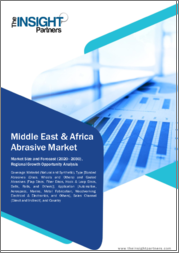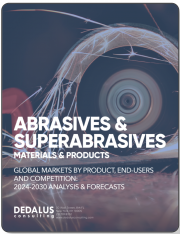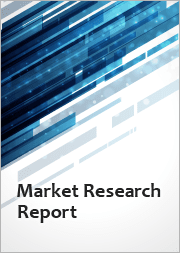
|
시장보고서
상품코드
1567816
아시아태평양의 연마재 시장 예측(-2030년) : 지역 분석 - 재질별, 유형별, 용도별, 판매 채널별Asia Pacific Abrasive Market Forecast to 2030 - Regional Analysis - by Material, Type, Application, and Sales Channel |
||||||
아시아태평양의 연마재 시장은 2022년에 212억 8,050만 달러로 평가되며, 2030년에는 316억 4,271만 달러에 달할 것으로 예상되며, 2022년부터 2030년까지 연평균 5.1%의 성장률을 보일 것으로 예상됩니다.
전기 및 전자 산업의 연마재 수요 증가로 아시아태평양의 연마재 시장 성장 촉진
연마재는 실장, 정밀 연삭, 연마, 생산 랩, 웨이퍼 연마 등 전자 및 포토닉스 분야에서 다양한 용도로 사용되고 있습니다. 전자 산업에서는 테스트 및 분석 시 안정성을 보장하기 위해 실장 장비에 높은 정밀도가 요구됩니다. 산화알루미늄과 탄화규소는 높은 경도와 치수 안정성으로 인해 일반적으로 실장 공정에 사용됩니다. 또한, 탄화붕소는 저밀도, 고경도, 내화학성으로 인해 세라믹 및 반도체 재료와 같은 섬세한 부품의 실장에 사용되고 있습니다. 전기자동차로의 전환과 내구소비재 수요 증가로 인한 전기 및 전자부품의 판매 증가는 부품 생산에 필요한 고효율 재료에 대한 수요를 촉진하고 있습니다.
Parker Hannifin Corporation의 보고서에 따르면, 컴퓨터 수치제어(CNC) 공작기계 세계 시장은 2026년까지 1,290억 달러에 달할 것으로 예상됩니다. 중국은 세계 최대의 전자 제품 제조 기지입니다. 저렴한 인건비, 숙련된 노동력 확보, 광범위한 공급망 등의 요인이 전자 산업의 성장을 촉진하고 있습니다. 인도 정부도 중국을 대체할 시장으로 인도를 적극 육성하고 있으며, Invest India에 따르면 세계 전자제품 제조 서비스 시장은 2026년까지 1조 1,450억 달러에 달할 것으로 예상되며, 2021-2026년 연평균 5.4%의 성장률을 기록할 것으로 예상됩니다. India Brand Equity Foundation에 따르면 인도의 전자제품 제조 산업은 2025년까지 5,200억 달러에 달할 것으로 예상됩니다. 일본 전자정보기술산업협회에 따르면, 세계 전자 및 IT 산업 생산액은 2023년 3조 5,266억 달러에 달할 것으로 예측됩니다.
아시아태평양의 연마재 시장 개요
아시아태평양 시장은 자동차 산업, 해양 산업, 항공우주 산업, 건설 산업의 가속화에 의해 주도되고 있습니다. 아시아태평양은 자동차 제조의 중심지이며 국내외 많은 기업들이 진출하고 있습니다. 중국 승용차협회(China Passenger Car Association)가 발표한 보고서에 따르면 2022년 테슬라(Tesla Inc.)는 8만 3,135대의 중국산 전기자동차를 납품해 2021년 대비 전기자동차 판매량이 증가했다고 합니다. 국제자동차제조업협회(OICA)에 따르면 아시아-오세아니아의 자동차 생산량은 2021년 4,680만 대에서 2022년 5,000만 대까지 증가할 것으로 예상했습니다. 자동차 부문의 성장은 경량 소재 및 전기자동차에 대한 수요와 결합하여 이러한 진화하는 요구 사항에 맞는 특수 연마재의 사용을 더욱 촉진하고 있습니다.
또한, 아시아태평양의 건설 붐도 큰 원동력이 되고 있습니다. 아시아개발은행은 '지속가능발전목표 2030'에 따라 아시아태평양에서 강력한 인프라를 구축하고, 포괄적이고 지속가능한 산업화를 촉진하며, 혁신을 촉진할 계획입니다. 인프라 구축은 아시아태평양의 많은 정부들의 관심사가 되고 있습니다. 교통망, 에너지 시설, 공공 시설 등 대규모 프로젝트에 대한 투자가 건설 자재 수요를 견인하고 있습니다. 이러한 프로젝트는 교통 편의성을 개선하고 경제 성장을 촉진하며 전반적인 삶의 질을 향상시키는 데 필수적입니다. 따라서 연마제는 이러한 중요한 인프라 계획의 계획과 실행을 지원하기 위해 높은 수요가 있습니다. DPIIT(Department for Promotion of Industry and Internal Trade)의 보고서에 따르면, 인도 정부는 개방적인 FDI 기준, 인프라 부문에 대한 대규모 예산 배분, 스마트시티 미션 등 여러 정책을 통해 인프라와건설 서비스를 강화할 계획입니다. 또한 보고서에 따르면, 인도 부동산 산업은 2030년까지 1조 달러에 달할 것으로 예상되며, 인프라 설비투자 규모는 전년 대비 34% 증가한 670만 달러에 달할 것으로 예측했습니다. 현재 진행중인 인프라 개발 및 도시화 프로젝트에 따라 건설 응용 분야에서 연마재에 대한 수요가 증가하고 있습니다. 콘크리트 표면의 성형 및 평활화에서 금속 구조물의 절단 및 마감에 이르기까지 연마재는 건설 프로젝트의 품질과 정밀도를 향상시키는 데 중요한 역할을 합니다. 또한 해상 무역 및 운송 부문이 확대됨에 따라 선박 건조 및 유지보수에 대한 요구가 증가하여 다양한 용도의 연마재에 대한 수요가 증가하고 있습니다. 중국, 일본, 한국은 조선 분야의 주요 국가입니다. 중화인민공화국 국무원에 따르면 2022년 중국의 조선 생산량은 961만 톤(dwt)으로 전년 대비 2.8% 포인트 증가해 세계 전체의 46.2%를 차지할 것으로 예상됩니다. 연마재는 선박 부품의 금속 표면을 매끄럽게하고 연마하는 데 중요한 역할을 합니다. 이는 미관을 유지하는 것뿐만 아니라 부식을 방지하고 선박의 수명을 연장하는 데에도 필수적입니다. 선박 건조는 복잡하고 규모가 크기 때문에 강철 및 다양한 합금을 포함한 다양한 조선 재료에 사용할 수 있는 연마재가 필요합니다. 또한, 아시아태평양의 금속 가공 산업은 금속 관련 제조 공정이 다양하고 광범위하기 때문에 연마재 수요를 견인하는 또 다른 큰 힘이 되고 있습니다. 연마재는 거친 모서리를 깎고, 두꺼운 금속판을 자르고, 복잡한 부품을 성형하는 등 정밀 가공에 필수적입니다. 금속 가공 작업에서 이러한 기본적인 역할은 아시아태평양의 안정적인 연마재 수요에 크게 기여하고 있습니다.
아시아태평양의 연마재 시장 매출 및 2030년까지의 예측(금액)
아시아태평양의 연마재 시장 세분화
아시아태평양의 연마재 시장은 재료, 유형, 용도, 판매 채널 및 국가별로 분류됩니다.
재료별로 아시아태평양의 연마재 시장은 천연과 합성으로 구분되며, 2022년 아시아태평양의 연마재 시장에서 합성 부문이 큰 비중을 차지했습니다.
유형별로 아시아태평양의 연마재 시장은 본드 연마재와 코팅 연마재로 구분되며, 2022년 아시아태평양의 연마재 시장에서 본드 연마재 부문이 큰 비중을 차지했습니다. 또한, 본드 연마재 부문은 디스크, 휠 및 기타로 세분화됩니다. 또한 코팅 연마재 부문은 플랩 디스크, 섬유 디스크, 후크 어 루프 디스크, 벨트, 롤 및 기타로 세분화됩니다.
용도별로 아시아태평양의 연마재 시장은 자동차, 항공우주, 해양, 금속 가공, 목공, 전기 및 전자, 기타로 구분되며, 2022년 아시아태평양의 연마재 시장에서 자동차 부문이 가장 큰 비중을 차지했습니다.
판매 채널에 따라 아시아태평양의 연마재 시장은 직접과 간접으로 나뉘며, 2022년 아시아태평양의 연마재 시장에서 간접 부문이 큰 비중을 차지했습니다.
국가별로 아시아태평양의 연마재 시장은 호주, 인도, 말레이시아, 기타 아시아태평양으로 구분됩니다. 기타 아시아태평양이 2022년 아시아태평양의 연마재 시장 점유율을 차지했습니다.
Deerfos Co.Ltd., CUMI AWUKO Abrasives GmbH, Robert Bosch GmbH, Tyrolit Schleifmittelwerke Swarovski AG &Co KG, Sun Abrasives Co Ltd, Compagnie de Saint-Gobain S.A., sia Abrasives Industries AG, RHODIUS Abrasives GmbH, 3M Co., Ekamant AB 등이 아시아태평양의 연마재 시장에서 활동하는 주요 기업들입니다.
목차
제1장 소개
제2장 주요 요약
- 주요 인사이트
- 시장 매력
제3장 조사 방법
- 조사 범위
- 2차 조사
- 1차 조사
제4장 연마재 시장 상황
- Porters 분석
- 공급 기업의 교섭력
- 구매자의 교섭력
- 신규 참여업체의 위협
- 경쟁 기업 간의 경쟁 관계
- 대체품의 위협
- 생태계 분석
- 각종 연마 미디어 특성
- 밸류체인 벤더 리스트
제5장 아시아태평양의 연마재 시장 : 주요 시장 역학
- 시장 성장 촉진요인
- 성장하는 자동차 산업과 금속 가공 산업
- 전기·전자 산업으로부터의 연마재 수요 증가
- 시장 성장 억제요인
- 원자재 가격 변동
- 시장 기회
- 자동화·로봇 용도에서의 연마재 채용
- 향후 동향
- 지속가능한 연마재 개발
- 성장 촉진요인과 억제요인의 영향
제6장 연마재 시장 : 아시아태평양의 분석
- 연마재 시장 매출, 2020-2030년
- 연마재 시장 예측 분석
제7장 아시아태평양의 연마재 시장 분석 : 재질별
- 천연
- 합성
제8장 아시아태평양의 연마재 시장 분석 : 유형별
- 본드 연마 입자
- 코팅 연마 입자
제9장 아시아태평양의 연마재 시장 분석 : 용도별
- 자동차
- 항공우주
- 해양
- 금속 가공
- 목공
- 전기·전자
- 기타
제10장 아시아태평양의 연마재 시장 분석 : 판매 채널별
- 직접
- 간접 판매
제11장 아시아태평양의 연마재 시장 : 국가별 분석
- 아시아태평양
- 호주
- 인도
- 말레이시아
- 기타 아시아태평양
제12장 경쟁 상황
- 주요 기업에 의한 히트맵 분석
- 기업 포지셔닝과 집중도
제13장 업계 상황
- 제품 발매
- 인수합병
- 사업 확대
- 기타 전략과 전개
제14장 기업 개요
- Deerfos Co., Ltd.
- CUMI AWUKO Abrasives GmbH
- Robert Bosch GmbH
- Tyrolit Schleifmittelwerke Swarovski AG & Co KG
- Sun Abrasives Co Ltd
- Compagnie de Saint-Gobain S.A.
- sia Abrasives Industries AG
- RHODIUS Abrasives GmbH
- 3M Co
- Ekamant AB
제15장 부록
ksm 24.10.24The Asia Pacific abrasive market was valued at US$ 21,280.50 million in 2022 and is expected to reach US$ 31,642.71 million by 2030; it is estimated to register a CAGR of 5.1% from 2022 to 2030.
Rising Demand for Abrasives from Electrical and Electronics Industry Boosts Asia Pacific Abrasive Market
Abrasives are used in a variety of electronics and photonics applications such as mounting, precision grinding, polishing, production lapping, and wafer polishing. In the electronics industry, mounting devices require high precision to ensure their stability during testing and analysis. Aluminum oxide and silicon carbide are generally used in mounting processes due to their high hardness and dimensional stability. Boron carbide is also used for mounting sensitive components such as ceramics and semiconductor materials due to its low density, high hardness, and chemical resistance. The rising sales of electrical and electronic components due to the transition toward electric vehicles and growing demand for electronic consumer durables have fueled the demand for high-efficiency materials required for component production.
As per the Parker Hannifin Corporation report, the global market for computer numerically controlled (CNC) machine tools is projected to reach US$ 129 billion by 2026. China is the largest manufacturing hub of electronics in the world. Factors such as low labor costs, availability of skilled labor, and prevalent supply chains are driving the growth of the electronics industry. The government of India is also showing an aggressive approach to promoting the country as an alternative market to China. According to Invest India, the global electronics manufacturing services market is anticipated to reach US$ 1,145 billion by 2026, recording a CAGR of 5.4% during 2021-2026. The India Brand Equity Foundation states that the Indian electronics manufacturing industry is projected to reach US$ 520 billion by 2025. According to the Japan Electronics and Information Technology Industries Association, the production by the global electronics and IT industries was projected to reach US$ 3,526.6 billion in 2023.
Asia Pacific Abrasive Market Overview
The market in Asia Pacific is driven by accelerating automotive, marine, aerospace, and construction industries. Asia Pacific is a hub for automotive manufacturing with a large presence of international and domestic players operating in the region. According to a report published by the China Passenger Car Association, in 2022, Tesla Inc delivered 83,135 made-in-China electric vehicles, indicating growth in sales of electric vehicles compared to 2021. According to the Organisation Internationale des Constructeurs d'Automobiles (OICA), Asia-Oceania's vehicle production increased from 46.8 million in 2021 to 50 million in 2022. The automotive sector's growth, coupled with the demand for lightweight materials and electrical vehicles, further propels the utilization of specialized abrasives tailored to these evolving requirements.
Moreover, the construction boom in Asia Pacific is another major driver. Under the Sustainable Development Goals 2030, the Asian Development Bank has planned to build resilient infrastructure, promote inclusive and sustainable industrialization, and foster innovation in Asia Pacific. Infrastructure development has been a focal point for many governments across Asia Pacific. Investments in large-scale projects, such as transportation networks, energy facilities, and public amenities, have driven demand for construction materials. These projects are essential for improving connectivity, fostering economic growth, and enhancing the overall quality of life. As a result, abrasives are in high demand to support the planning and execution of these vital infrastructure initiatives. According to the report by the Department for Promotion of Industry and Internal Trade (DPIIT), the Government of India has planned to boost the infrastructure and construction services through several policies such as open FDI norms, large budget allocation to the infrastructure sector, and smart cities mission. The report also stated that the real estate industry in India is projected to reach US$ 1 trillion by 2030, along with an increased year-on-year infrastructure Capex by 34% to reach US$ 6.7 million. With ongoing infrastructure development and urbanization projects, there is an increased requirement for abrasives in construction applications. From shaping and smoothing concrete surfaces to cutting and finishing metal structures, abrasives play a vital role in enhancing the quality and precision of construction projects. In addition, as the maritime trade and transportation sectors expand, there is an increasing need for ship construction and maintenance, stimulating the demand for abrasives in various applications. China, Japan, and South Korea are leading countries in the shipbuilding sector. According to the States Council of the People's Republic of China, the shipbuilding output of China was 9.61 million deadweight tons (dwt) in 2022, i.e., up by 2.8 percentage points year-on-year, accounting for 46.2% of the global total. Abrasives play a crucial role in smoothing and polishing the metal surfaces of ship components. This is essential not only for aesthetic purposes but also for preventing corrosion and ensuring the longevity of the vessels. The intricate and large-scale nature of ship construction requires abrasives that can handle diverse materials used in shipbuilding, including steel and various alloys. Furthermore, Asia Pacific's metalworking industry is another major force driving the demand for abrasives due to the diverse and expansive nature of metal-related manufacturing processes across the region. Abrasives are indispensable for precision machining, whether grinding down rough edges, cutting through thick metal sheets, or shaping intricate parts. This foundational role in metalworking operations contributes significantly to the consistent demand for abrasives in Asia Pacific.
Asia Pacific Abrasive Market Revenue and Forecast to 2030 (US$ Million)
Asia Pacific Abrasive Market Segmentation
The Asia Pacific abrasive market is categorized into material, type, application, sales channel, and country.
By material, the Asia Pacific abrasive market is bifurcated into natural and synthetic. The synthetic segment held a larger share of Asia Pacific abrasive market in 2022.
In terms of type, the Asia Pacific abrasive market is bifurcated into bonded abrasives and coated abrasives. The bonded abrasives segment held a larger share of Asia Pacific abrasive market in 2022. Furthermore, the bonded abrasives segment is subcategorized into discs, wheels, and others. Additionally, the coated abrasives segment is subcategorized into flap discs, fiber discs, hook a loop discs, belts, rolls, and others.
By application, the Asia Pacific abrasive market is segmented into automotive, aerospace, marine, metal fabrication, woodworking, electrical & electronics, and others. The automotive segment held the largest share of Asia Pacific abrasive market in 2022.
Based on sales channel, the Asia Pacific abrasive market is bifurcated into direct and indirect. The indirect segment held a larger share of Asia Pacific abrasive market in 2022.
By country, the Asia Pacific abrasive market is segmented into Australia, India, Malaysia, and the Rest of Asia Pacific. The Rest of Asia Pacific dominated the Asia Pacific abrasive market share in 2022.
Deerfos Co., Ltd; CUMI AWUKO Abrasives GmbH; Robert Bosch GmbH; Tyrolit Schleifmittelwerke Swarovski AG & Co KG; Sun Abrasives Co Ltd; Compagnie de Saint-Gobain S.A.; sia Abrasives Industries AG; RHODIUS Abrasives GmbH; 3M Co; and Ekamant AB are some of the leading companies operating in the Asia Pacific abrasive market.
Table Of Contents
1. Introduction
- 1.1 The Insight Partners Research Report Guidance
- 1.2 Market Segmentation
2. Executive Summary
- 2.1 Key Insights
- 2.2 Market Attractiveness
3. Research Methodology
- 3.1 Coverage
- 3.2 Secondary Research
- 3.3 Primary Research
4. Abrasive Market Landscape
- 4.1 Overview
- 4.2 Porters Analysis
- 4.2.1 Bargaining Power of Suppliers
- 4.2.2 Bargaining Power of Buyers
- 4.2.3 Threat of New Entrants
- 4.2.4 Intensity of Competitive Rivalry
- 4.2.5 Threat of Substitutes
- 4.3 Ecosystem Analysis
- 4.3.1 Properties of Different Abrasive Media Types
- 4.3.2 List of Vendors in the Value Chain
5. Asia Pacific Abrasive Market - Key Market Dynamics
- 5.1 Market Drivers
- 5.1.1 Growing Automotive and Metal Fabrication Industry
- 5.1.2 Rising Demand for Abrasives from Electrical and Electronics Industry
- 5.2 Market Restraints
- 5.2.1 Fluctuations in Raw Material Prices
- 5.3 Market Opportunities
- 5.3.1 Adoption of Abrasives in Automation and Robotic Applications
- 5.4 Future Trends
- 5.4.1 Development of Sustainable Abrasives
- 5.5 Impact of Drivers and Restraints:
6. Abrasive Market -Asia Pacific Analysis
- 6.1 Overview
- 6.2 Abrasive Market Revenue (US$ Million), 2020-2030
- 6.3 Abrasive Market Forecast Analysis
7. Asia Pacific Abrasive Market Analysis - by Material
- 7.1 Natural
- 7.1.1 Overview
- 7.1.2 Natural: Abrasive Market - Revenue and Forecast to 2030 (US$ Million)
- 7.2 Synthetic
- 7.2.1 Overview
- 7.2.2 Synthetic: Abrasive Market - Revenue and Forecast to 2030 (US$ Million)
8. Asia Pacific Abrasive Market Analysis - by Type
- 8.1 Bonded Abrasives
- 8.1.1 Overview
- 8.1.2 Bonded Abrasives: Abrasive Market - Revenue and Forecast to 2030 (US$ Million)
- 8.1.3 Discs
- 8.1.3.1 Overview
- 8.1.3.2 Discs: Abrasive Market - Revenue and Forecast to 2030 (US$ Million)
- 8.1.4 Wheels
- 8.1.4.1 Overview
- 8.1.4.2 Wheels: Abrasive Market - Revenue and Forecast to 2030 (US$ Million)
- 8.1.5 Others
- 8.1.5.1 Overview
- 8.1.5.2 Others: Abrasive Market - Revenue and Forecast to 2030 (US$ Million)
- 8.2 Coated Abrasives
- 8.2.1 Overview
- 8.2.1.1 Coated Abrasives: Abrasive Market - Revenue and Forecast to 2030 (US$ Million)
- 8.2.2 Flap Discs
- 8.2.2.1 Overview
- 8.2.2.2 Flap Discs: Abrasive Market - Revenue and Forecast to 2030 (US$ Million)
- 8.2.3 Fiber Discs
- 8.2.3.1 Overview
- 8.2.3.2 Fiber Discs: Abrasive Market - Revenue and Forecast to 2030 (US$ Million)
- 8.2.4 Hook and Loop Discs
- 8.2.4.1 Overview
- 8.2.4.2 Hook and Loop Discs: Abrasive Market - Revenue and Forecast to 2030 (US$ Million)
- 8.2.5 Belts
- 8.2.5.1 Overview
- 8.2.5.2 Belts: Abrasive Market - Revenue and Forecast to 2030 (US$ Million)
- 8.2.6 Rolls
- 8.2.6.1 Overview
- 8.2.6.2 Rolls: Abrasive Market - Revenue and Forecast to 2030 (US$ Million)
- 8.2.7 Others
- 8.2.7.1 Overview
- 8.2.7.2 Others: Abrasive Market - Revenue and Forecast to 2030 (US$ Million)
- 8.2.1 Overview
9. Asia Pacific Abrasive Market Analysis - by Application
- 9.1 Automotive
- 9.1.1 Overview
- 9.1.2 Automotive: Abrasive Market - Revenue and Forecast to 2030 (US$ Million)
- 9.2 Aerospace
- 9.2.1 Overview
- 9.2.2 Aerospace: Abrasive Market - Revenue and Forecast to 2030 (US$ Million)
- 9.3 Marine
- 9.3.1 Overview
- 9.3.2 Marine: Abrasive Market - Revenue and Forecast to 2030 (US$ Million)
- 9.4 Metal Fabrication
- 9.4.1 Overview
- 9.4.2 Metal Fabrication: Abrasive Market - Revenue and Forecast to 2030 (US$ Million)
- 9.5 Woodworking
- 9.5.1 Overview
- 9.5.2 Woodworking: Abrasive Market - Revenue and Forecast to 2030 (US$ Million)
- 9.6 Electrical and Electronics
- 9.6.1 Overview
- 9.6.2 Electrical and Electronics: Abrasive Market - Revenue and Forecast to 2030 (US$ Million)
- 9.7 Others
- 9.7.1 Overview
- 9.7.2 Others: Abrasive Market - Revenue and Forecast to 2030 (US$ Million)
10. Asia Pacific Abrasive Market Analysis - by Sales Channel
- 10.1 Direct
- 10.1.1 Overview
- 10.1.2 Direct: Abrasive Market - Revenue and Forecast to 2030 (US$ Million)
- 10.2 Indirect
- 10.2.1 Overview
- 10.2.2 Indirect: Abrasive Market - Revenue and Forecast to 2030 (US$ Million)
11. Asia Pacific Abrasive Market - Country Analysis
- 11.1 Asia Pacific
- 11.1.1 Asia Pacific: Abrasive Market - Revenue and Forecast Analysis - by Country
- 11.1.1.1 Australia: Abrasive Market - Revenue and Forecast to 2030 (US$ Million)
- 11.1.1.1.1 Australia: Abrasive Market Breakdown, by Material
- 11.1.1.1.2 Australia: Abrasive Market Breakdown, by Type
- 11.1.1.1.3 Australia: Abrasive Market Breakdown, by Application
- 11.1.1.1.4 Australia: Abrasive Market Breakdown, by Sales Channel
- 11.1.1.2 India: Abrasive Market - Revenue and Forecast to 2030 (US$ Million)
- 11.1.1.2.1 India: Abrasive Market Breakdown, by Material
- 11.1.1.2.2 India: Abrasive Market Breakdown, by Type
- 11.1.1.2.3 India: Abrasive Market Breakdown, by Application
- 11.1.1.2.4 India: Abrasive Market Breakdown, by Sales Channel
- 11.1.1.3 Malaysia: Abrasive Market - Revenue and Forecast to 2030 (US$ Million)
- 11.1.1.3.1 Malaysia: Abrasive Market Breakdown, by Material
- 11.1.1.3.2 Malaysia: Abrasive Market Breakdown, by Type
- 11.1.1.3.3 Malaysia: Abrasive Market Breakdown, by Application
- 11.1.1.3.4 Malaysia: Abrasive Market Breakdown, by Sales Channel
- 11.1.1.4 Rest of Asia Pacific: Abrasive Market - Revenue and Forecast to 2030 (US$ Million)
- 11.1.1.4.1 Rest of Asia Pacific: Abrasive Market Breakdown, by Material
- 11.1.1.4.2 Rest of Asia Pacific: Abrasive Market Breakdown, by Type
- 11.1.1.4.3 Rest of Asia Pacific: Abrasive Market Breakdown, by Application
- 11.1.1.4.4 Rest of Asia Pacific: Abrasive Market Breakdown, by Sales Channel
- 11.1.1.1 Australia: Abrasive Market - Revenue and Forecast to 2030 (US$ Million)
- 11.1.1 Asia Pacific: Abrasive Market - Revenue and Forecast Analysis - by Country
12. Competitive Landscape
- 12.1 Heat Map Analysis by Key Players
- 12.2 Company Positioning & Concentration
13. Industry Landscape
- 13.1 Overview
- 13.2 Product launch
- 13.3 Mergers and Acquisitions
- 13.4 Expansion
- 13.5 Other Strategies and Developments
14. Company Profiles
- 14.1 Deerfos Co., Ltd.
- 14.1.1 Key Facts
- 14.1.2 Business Description
- 14.1.3 Products and Services
- 14.1.4 Financial Overview
- 14.1.5 SWOT Analysis
- 14.1.6 Key Developments
- 14.2 CUMI AWUKO Abrasives GmbH
- 14.2.1 Key Facts
- 14.2.2 Business Description
- 14.2.3 Products and Services
- 14.2.4 Financial Overview
- 14.2.5 SWOT Analysis
- 14.2.6 Key Developments
- 14.3 Robert Bosch GmbH
- 14.3.1 Key Facts
- 14.3.2 Business Description
- 14.3.3 Products and Services
- 14.3.4 Financial Overview
- 14.3.5 SWOT Analysis
- 14.3.6 Key Developments
- 14.4 Tyrolit Schleifmittelwerke Swarovski AG & Co KG
- 14.4.1 Key Facts
- 14.4.2 Business Description
- 14.4.3 Products and Services
- 14.4.4 Financial Overview
- 14.4.5 SWOT Analysis
- 14.4.6 Key Developments
- 14.5 Sun Abrasives Co Ltd
- 14.5.1 Key Facts
- 14.5.2 Business Description
- 14.5.3 Products and Services
- 14.5.4 Financial Overview
- 14.5.5 SWOT Analysis
- 14.5.6 Key Developments
- 14.6 Compagnie de Saint-Gobain S.A.
- 14.6.1 Key Facts
- 14.6.2 Business Description
- 14.6.3 Products and Services
- 14.6.4 Financial Overview
- 14.6.5 SWOT Analysis
- 14.6.6 Key Developments
- 14.7 sia Abrasives Industries AG
- 14.7.1 Key Facts
- 14.7.2 Business Description
- 14.7.3 Products and Services
- 14.7.4 Financial Overview
- 14.7.5 SWOT Analysis
- 14.7.6 Key Developments
- 14.8 RHODIUS Abrasives GmbH
- 14.8.1 Key Facts
- 14.8.2 Business Description
- 14.8.3 Products and Services
- 14.8.4 Financial Overview
- 14.8.5 SWOT Analysis
- 14.8.6 Key Developments
- 14.9 3M Co
- 14.9.1 Key Facts
- 14.9.2 Business Description
- 14.9.3 Products and Services
- 14.9.4 Financial Overview
- 14.9.5 SWOT Analysis
- 14.9.6 Key Developments
- 14.10 Ekamant AB
- 14.10.1 Key Facts
- 14.10.2 Business Description
- 14.10.3 Products and Services
- 14.10.4 Financial Overview
- 14.10.5 SWOT Analysis
- 14.10.6 Key Developments
15. Appendix
- 15.1 About the Insight Partners



















